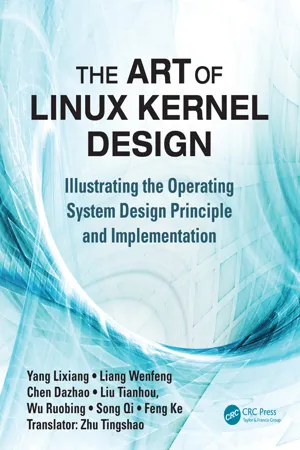
The Art of Linux Kernel Design
Illustrating the Operating System Design Principle and Implementation
- 534 pages
- English
- ePUB (mobile friendly)
- Available on iOS & Android
The Art of Linux Kernel Design
Illustrating the Operating System Design Principle and Implementation
About This Book
Uses the Running Operation as the Main Thread
Difficulty in understanding an operating system (OS) lies not in the technical aspects, but in the complex relationships inside the operating systems. The Art of Linux Kernel Design: Illustrating the Operating System Design Principle and Implementation addresses this complexity. Written from the perspective of the designer of an operating system, this book tackles important issues and practical problems on how to understand an operating system completely and systematically. It removes the mystery, revealing operating system design guidelines, explaining the BIOS code directly related to the operating system, and simplifying the relationships and guiding ideology behind it all.
Based on the Source Code of a Real Multi-Process Operating System
Using the 0.11 edition source code as a representation of the Linux basic design, the book illustrates the real states of an operating system in actual operations. It provides a complete, systematic analysis of the operating system source code, as well as a direct and complete understanding of the real operating system run-time structure. The author includes run-time memory structure diagrams, and an accompanying essay to help readers grasp the dynamics behind Linux and similar software systems.
-
- Identifies through diagrams the location of the key operating system data structures that lie in the memory
- Indicates through diagrams the current operating status information which helps users understand the interrupt state, and left time slice of processes
- Examines the relationship between process and memory, memory and file, file and process, and the kernel
- Explores the essential association, preparation, and transition, which is the vital part of operating system
-
Develop a System of Your Own
This text offers an in-depth study on mastering the operating system, and provides an important prerequisite for designing a whole new operating system.
Frequently asked questions
Information
Table of contents
- Cover
- Half Title
- Title Page
- Copyright Page
- Table of Contents
- Preface
- Author
- 1. From Power-Up to the Main Function
- 2. Device Initialization and Process 0 Activation
- 3. Creation and Execution of Process 1
- 4. Creation and Execution of Process 2
- 5. File Operation
- 6. The User Process and Memory Management
- 7. Buffer and Multiprocess File
- 8. Inter-Process Communication
- 9. Operating System’s Design Guidelines
- Index